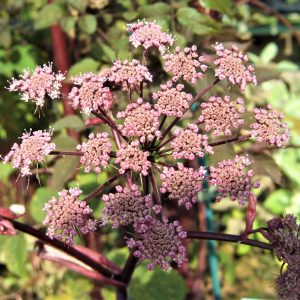Angelica, a stately and aromatic herb, is known for its tall, umbel-shaped flower clusters and culinary or medicinal uses. Follow this comprehensive planting guide to ensure the successful establishment and growth of your Angelica plants.
Selecting the Planting Site
Sunlight Requirements: Choose a planting site with partial shade to full sun. Angelica prefers partial shade, especially in warmer climates.
Soil Conditions: Plant Angelica in moist, well-draining soil rich in organic matter. The soil should have a slightly acidic to neutral pH.
Planting Time
Optimal Timing: Plant Angelica in the spring or Autumn for best results. Cooler temperatures are ideal for initial growth.
Planting Process
Prepare the Soil: Work the soil to a depth of 12 to 18 inches, incorporating compost or well-rotted manure for fertility.
Seed Planting: If starting from seeds, sow them directly in the garden or in containers. Press the seeds lightly into the soil and cover them with a thin layer.
Transplanting: If planting seedlings or young plants, space them about 18 to 24 inches apart to allow for their mature size.
Watering
Consistent Moisture: Keep the soil consistently moist. Angelica plants thrive in consistently moist conditions, so regular watering is crucial.
Mulching: Apply a layer of organic mulch around the plants to help retain moisture and suppress weeds.
Fertilisation
Organic Fertiliser: Use organic fertilisers, such as well-rotted compost, in the planting hole. Angelica doesn’t require heavy feeding but benefits from nutrient-rich soil.
Support
Staking Tall Varieties: Stake taller Angelica varieties to provide support, especially as the plants develop heavy flower heads.
Pruning
Deadheading: Remove spent flowers to encourage continuous blooming and prevent self-seeding.
Autumn Clean up: Trim back the foliage in late Autumn to tidy up the plants and prepare them for winter.
Pest and Disease Management
Aphid Control: Keep an eye out for aphids, especially during the growing season. Treat any infestations promptly.
Good Air Circulation: Proper spacing between plants promotes good air circulation, reducing the risk of fungal diseases.
Winter Care
Mulching in Winter: Apply a layer of mulch in late Autumn to protect the roots during winter. This is particularly important in colder climates.
Harvesting
Harvesting Leaves: Harvest leaves when they are young and tender for culinary use. Cut them near the base of the plant.
Harvesting Seeds: Allow some flower heads to mature and collect the seeds for culinary or medicinal purposes.
Division
Periodic Division: Consider dividing mature Angelica plants every 2-3 years to rejuvenate them. Spring is the ideal time for division.
Adaptation
Recognise Plant’s Size: Angelica plants can grow tall, so be mindful of their mature size when planning their location in the garden.
By following these guidelines, you’ll establish a healthy and productive Angelica. Adjust care based on your specific growing conditions and enjoy the unique beauty and uses of this remarkable herb.






